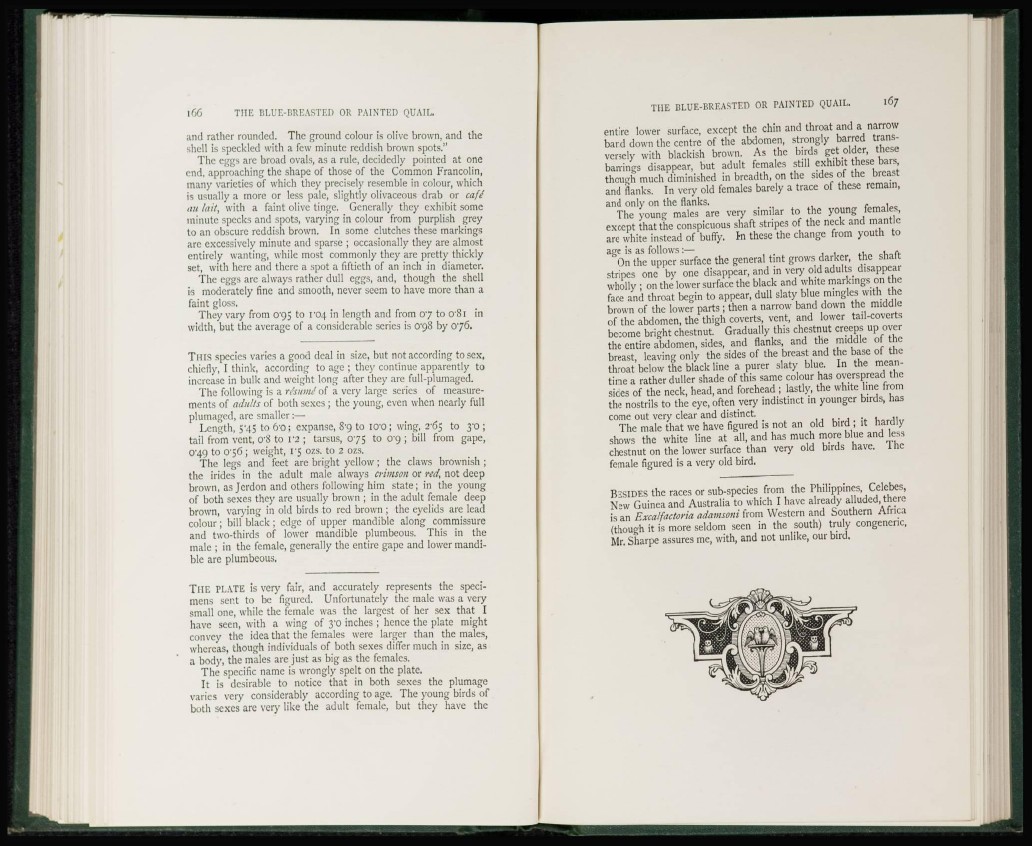
and rather rounded. The ground colour is olive brown, and the
shell is speckled with a few minute reddish brown spots."
The eggs arc broad ovals, as a rule, decidedly pointed at one
end, approaching the shape of those of the Common Francolin,
many varieties of which they precisely resemble in colour, which
is usually a more or less pale, slightly olivaceous drab or ca/ef
an lait, with a faint olive tinge. Generally they exhibit some
minute specks and spots, varying in colour from purplish grey
to an obscure reddish brown. In some clutches these markings
arc excessively minute and sparse ; occasionally they are almost
entirely wanting, while most commonly they are pretty thickly
set, with here and there a spot a fiftieth of an inch in diameter.
The eggs are always rather dull eggs, and, though the shell
is moderately fine and smooth, never seem to have more than a
faint gloss.
They vary from 0'95 to r04 in length and from 07 to 081 in
width, but the average of a considerable scries is 0^98 by 076.
Tins species varies a good deal in size, but not according to sex,
chiefly, I think, according to age ; they continue apparently to
increase in bulk and weight long after they are full-plumaged.
The following is a r/sumtf of a very large series of measurements
of adults of both sexes ; the young, even when nearly full
plumaged, arc smaller :—•
Length, 5*45 to 60; expanse, 8'9 to IO'O ; wing. 2'6$ to 3'0 ;
tail from vent, 0'8 to V2 ; tarsus, 075 to 0'9 ; bill from gape,
C49 to C 5 6 ; weight, i-5 ozs. to 2 ozs.
The legs and feet are bright yellow ; the claws brownish ;
the irides in the adult male always crimson or red, not deep
brown, as Jerdon and others following him state; in the young
of both sexes they arc usually brown ; in the adult female deep
brown, varying in old birds to red brown ; the eyelids are lead
colour; bill black ; edge of upper mandible along commissure
and two-thirds of lower mandible plumbeous. This in the
male ; in the female, generally the entire gape and lower mandible
are plumbeous.
THE PLATE is very fair, and accurately represents the specimens
sent to be figured. Unfortunately the male was a very
small one, while the female was the largest of her sex that I
have seen, with a wing of 3'0 inches ; hence the plate might
convey the idea that the females were larger than the males,
whereas, though individuals of both sexes differ much in size, as
a bod)-, the males are just as big as the females.
The specific name is wrongly spelt on the plate.
It is desirable to notice that in both sexes the plumage
varies very considerably according to age. The young birds of
both sexes are very like the adult female, but they have the
THE BLUE-BREASTED OR PAINTED QUAIL.
entire lower surface, except the chin and throat and a narrow
band down the centre of the abdomen, strongly barred transversely
with blackish brown. As the birds get older, these
barrings disappear, but adult females still exhibit these bars,
though much diminished in breadth, on the sides of the breast
and flanks. In very old females barely a trace of these remain,
and only on the flanks.
The young males are very similar to the young females,
except that the conspicuous shaft stripes of the neck and mantle
are white instead of buffy. In these the change from youth to
age is as follows :—
On the upper surface the general tint grows darker, the shaft
stripes one by one disappear, and in very old adults disappear
wholly ; on the lower surface the black and white markings on the
face and throat begin to appear, dull slaty blue mingles with the
brown of the lower parts ; then a narrow band down the middle
of the abdomen, the thigh coverts, vent, and lower tail-coverts
become bright chestnut. Gradually this chestnut creeps up over
the entire abdomen, sides, and flanks, and the middle of the
breast, leaving only the sides of the breast and the base of the
throat below the black line a purer slaty blue. In the meantime
a rather duller shade of this same colour has overspread the
sides of the neck, head, and forehead ; lastly, the white line from
the nostrils to the eye, often very indistinct in younger birds, has
come out very clear and distinct.
The male that we have figured is not an old bird ; it hardly
shows the white line at all, and has much more blue and less
chestnut on the lower surface than very old birds have. The
female figured is a very old bird.
BESIDES the races or sub-species from the Philippines, Celebes,
New Guinea and Australia to which I have already alluded, there
is an Excalfactoria adamsoni from Western and Southern Ainca
(though it is more seldom seen in the south) truly congeneric,
Mr. Sharpe assures me, with, and not unlike, our bird.